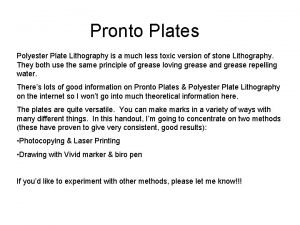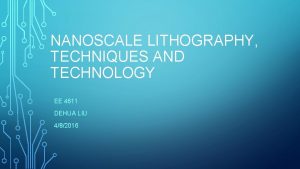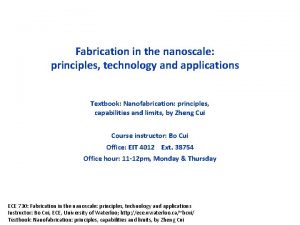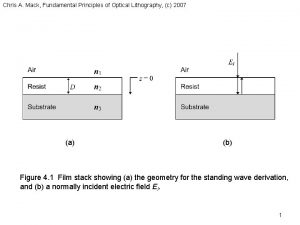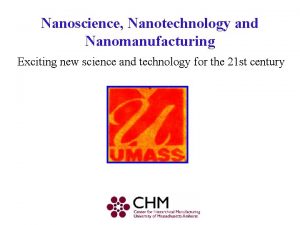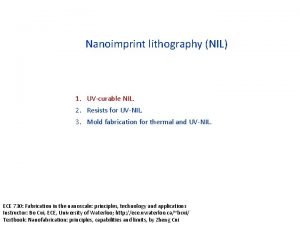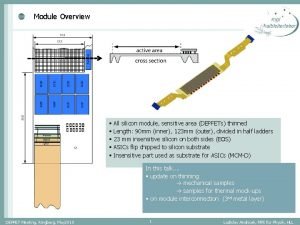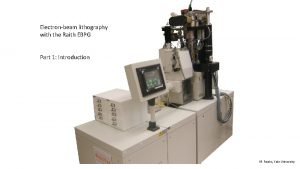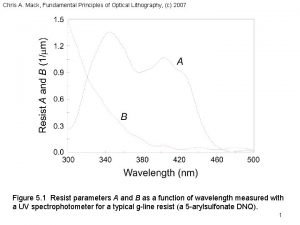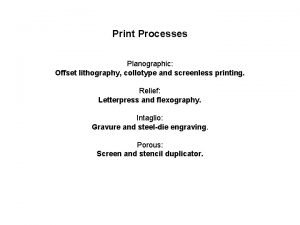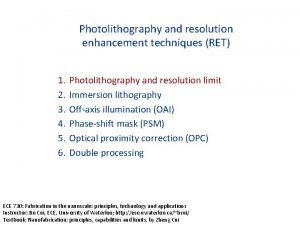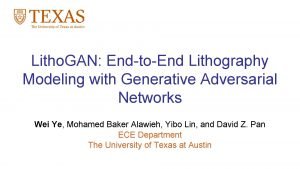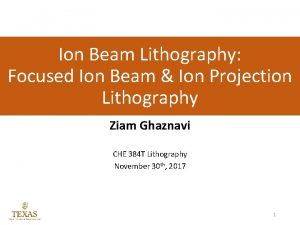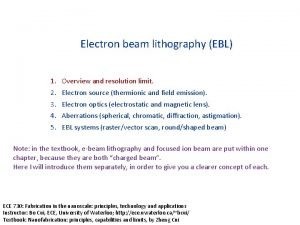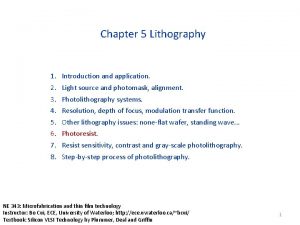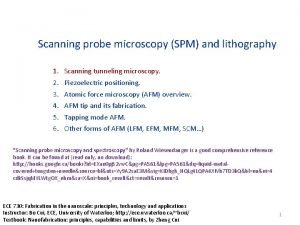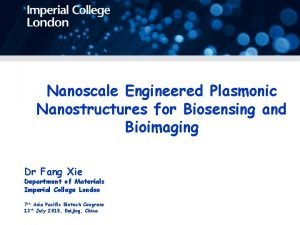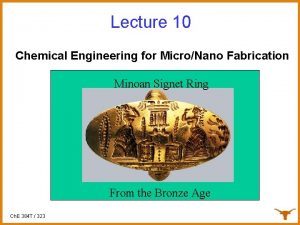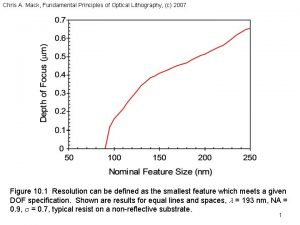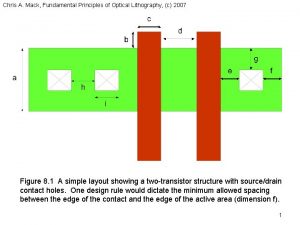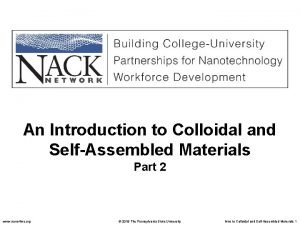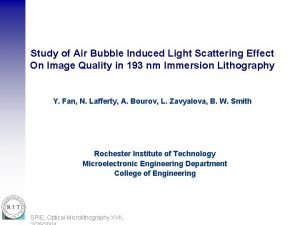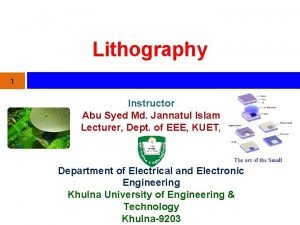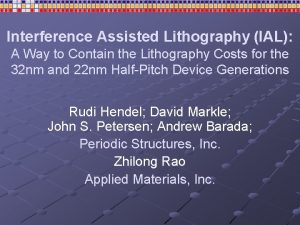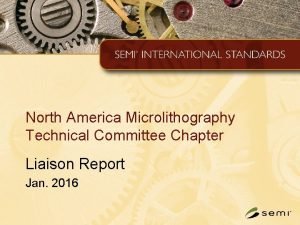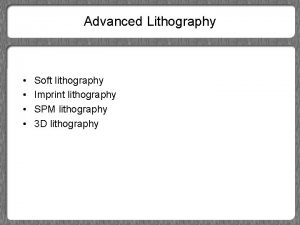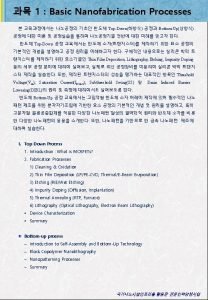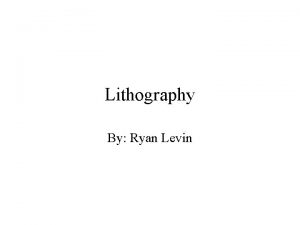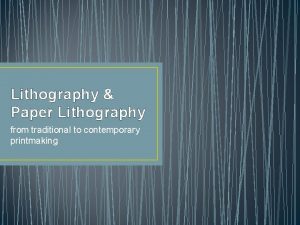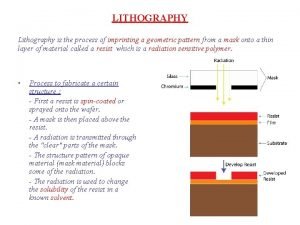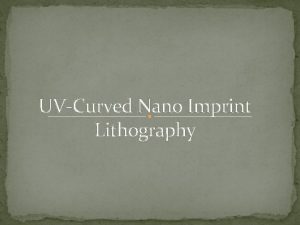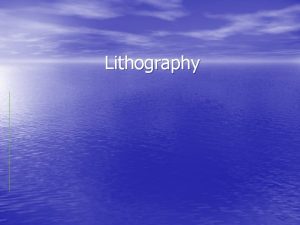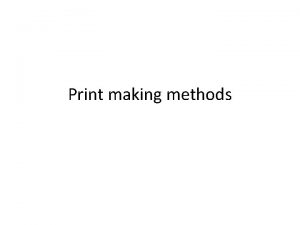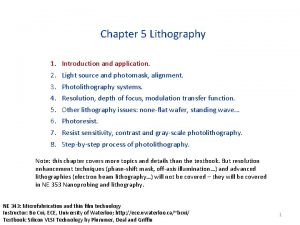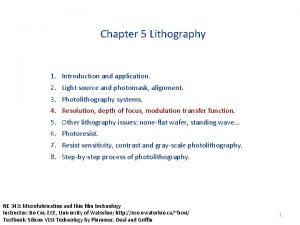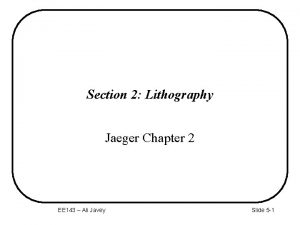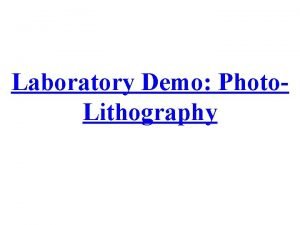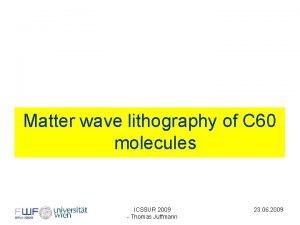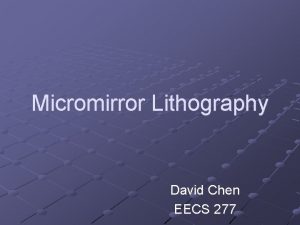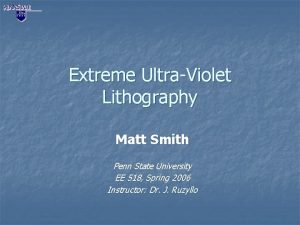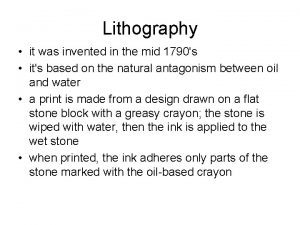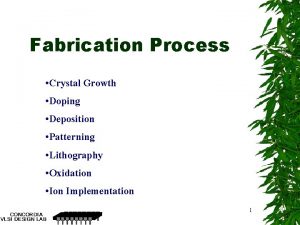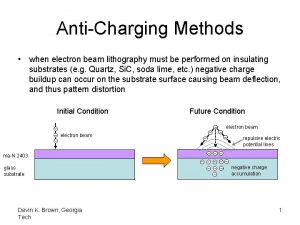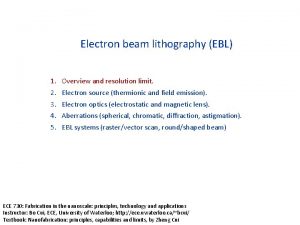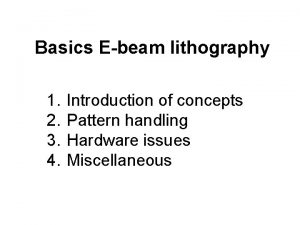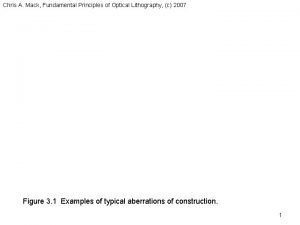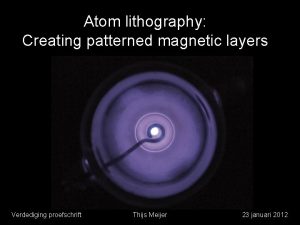Chapter 5 Lithography 1 2 3 4 5






































- Slides: 38

Chapter 5 Lithography 1. 2. 3. 4. 5. 6. 7. 8. Introduction and application. Light source and photomask, alignment. Photolithography systems. Resolution, depth of focus, modulation transfer function. Other lithography issues: none-flat wafer, standing wave. . . Photoresist. Resist sensitivity, contrast and gray-scale photolithography. Step-by-step process of photolithography. NE 343: Microfabrication and thin film technology Instructor: Bo Cui, ECE, University of Waterloo; http: //ece. uwaterloo. ca/~bcui/ Textbook: Silicon VLSI Technology by Plummer, Deal and Griffin 1

Photoresist overview Photoresist is a liquid mixture that can be spun onto a substrate, exposed and developed into a pattern for subsequent processing. Typically consists of 3 components: • Resin - a binder that provides mechanical properties (adhesion, chemical resistance…). • Sensitizer - photoactive compound. • Solvent – e. g. n-butyl acetate, xylene, keep the resist in a liquid form for spin coating. Its content determines viscosity and hence resist thickness. There are two types of photoresist: • Positive: exposed area removed by developer. • Negative: unexposed area removed by developer. Cr Mask Photoresist Positive Resist Negative Resist 2

Positive resist: DNQ • It is the most popular positive resists for i-line (365 nm) and g-line (436 nm) exposure, but cannot be used for very short . • It consist of diazonaphthoquinone (DNQ), which is the photoactive compound (PAC); and novolac, a matrix material called resin. • After spinning and baking, resists contains roughly 1: 1 PAC and resin. Novolac A polymer whose monomer is an aromatic ring with 2 methyl groups and an OH group. It dissolves easily in a base developer solution. Solvents are added to adjust the viscosity. Novolac DNQ (diazo-naphto-quinone) It is the PACs in these resists, and it acts as an inhibitor, reducing the dissolution rate of he resist in the developer. This occurs by a chemical bonding of the PAC and the novolac at the surface of the resist where it is exposed to the developer. DNQ Figure 5 -17 3

DNQ upon UV exposure Sensitizers: (here it is DNQ) • It is also called photoactive compounds (PAC). • It absorb radiation and undergo chemical reactions to change their chemical dissolution properties in developer. • The net result is Differential Dissolution rate (100: 1) between areas that absorbed radiation and areas that did not absorb radiation. • Sensitizers are developer resistant before they absorb radiation. Figure 5 -18 • Addition of UV light will free nitrogen molecule from the carbon ring leaving behind a highly reactive carbon site. • One way to stabilize the structure is to move one of the carbons outside the ring, and the oxygen atom is covalently bonded to this external carbon atom. • This process known as Wolff rearrangement. • In presence of water, the resulting ketene molecule finally transforms into carboxylic acid, which is readily soluble in basic developer (KOH, NAOH, TMAH etc). 4

Developing of DNQ resist and its advantage • Novolac resin is water soluble. • But due to the addition of the DNQ PAC (to the novolac matrix in) at about a 1: 1 ratio, the resist is almost insoluble in a base solution (p. H > 7). • Whereas after exposure, the generated carboxylic acid readily dissolve in base solutions. • The chemical reaction that occurs during this dissolution is the breakdown of the carboxylic acid into water-soluble amines such as aniline (phenylamine, one H in NH 3 replaced by a benzene ring, C 6 H 7 N). • This process continues until all of the exposed resist is removed. • Typical developer solutions are KOH or Na. OH diluted with water, yet in recent years the so-called MIF (metal ion free) developer based on TMAH dominates, because K + and Na+ ions are very bad for deveice. Dissolution rate in developer TMAH: tetra-methyl-ammonium hydroxide H in NH 4 OH replaced by CH 3 group. 5

Color of DNQ photoresist What should be the color of photoresist? 6

Photoresist properties • Resolution: how fine a line the resist can reproduce from an areal image. It is determined by contrast, thickness, proximity effects, swelling and contraction after development. • Contrast: ability of resist to distinguish between light and dark regions, measured by exposing resist of given thickness to varying radiation dose and measuring dissolution rate. • Sensitivity: incident energy necessary to produce the photochemical reactions required for defining patterns. It is related to quantum yield (=# of photon-induced events/# of photons absorbed). Higher sensitivity required at shorter wavelength because of limited brightness of UV sources and optics efficiency. Trade-off between exposure time and source brightness. • Etch resistance: Novolac is a long-chain aromatic ring polymer that is fairly resistant to chemical attack. Therefore, the resist is a good mask for wet or dry plasma etching. • Spectral response curve: should match the exposure light source. Example: resist sensitivity Photon energy E=hf=hc/ =4. 54 10 -19 J. Number of photons: (150 m. J/cm 2)/4. 54 10 -19 J =3. 3 1017/cm 2. Volume/photon=3. 3 10 -22/cm 3. Mean photon separation: (3. 3 10 -22/cm 3)1/3=0. 67 nm. 7

Negative photoresist • Negative photoresist becomes insoluble in regions exposed to light. • It is a polymer with long chains. Molecular weight 104 -106 kg/mol, about one order higher than that of DNQ positive resist. • Irradiation results in bonding or cross-linking (form 3 D molecular network) of adjacent polymer chains and increases of molecular weight. • Unexposed resists dissolve in aromatic solvents such as benzene, toluene and xylene. Cross-linked region Component of one negative photoresist • Resin: cyclized synthetic rubber resin, not sensitive to exposure, fast dissolution in organic solvent such as toluene and xylene. • Sensitizer PAC: bis-arylzide • Solvent: aromatic solvent • Developer: organic solvents (we know for positive resist, it is inorganic) 8

Comparison to positive resist Negative photoresist are: • Lower resolution due to solvent-induced swelling of exposed regions during development, which results in ragged edges or a loss of pattern fidelity and resolution. (For positive resist, much lower molecular weight and smaller chain, develops by “etching” - no swelling. ) • Less expensive. • More sensitive higher exposure throughput. • Relatively tolerant of developing conditions, wider process window. • Better chemical resistance better mask material for pattern transfer to under-layer. • Organic-based solvents vs. aqueous-based solvents for positive resist. Positive photoresist is much more expensive, therefore negative photoresist was used until it had to be replaced when the minimum feature size was shrunk to smaller than 3 m. Today DUV (deep UV) 193 nm resist is used for IC industry, the above positive or negative resists are no longer in use. But for R&D, many different fancy resists are used, some (e. g. AZ-5214 resist) can even be used as both positive and negative resist (but processed differently)! 9

Deep UV (DUV) resists • Traditional g-line and i-line resists have maximum quantum efficiencies ≈30% that limits sensitivity. In addition, it absorbs too strongly for < I line (=365 nm). • Chemical amplification can improve sensitivity significantly, with effective quantum efficiency >>100%. • DUV resists are all chemically amplified resist (again, this is true only for industrial application; for R&D, even a simple polymer like PMMA can be used as DUV resist). • Photo-acid generator (PAG) is converted to an acid by photon exposure. Later, in a post exposure bake (PEB), the acid molecule reacts with a “blocking” molecule on a polymer chain, making it soluble in developer and regenerating the acid molecule. • It is basically a catalytic chain reaction. In principle, only one photon is needed to generate one “seed” (acid catalyst), and all the rest reaction takes place during PEB. (this also means that PEB temperature needs to be tightly controlled for reproducible result) Figure 5 -19 Basic operation of a chemically amplified resist. PAG is photo-acid generator, INSOL and SOL are the insoluble and soluble portions of the polymer base. 10

Chapter 5 Lithography 1. 2. 3. 4. 5. 6. 7. 8. Introduction and application. Light source and photomask, alignment. Photolithography systems. Resolution, depth of focus, modulation transfer function. Other lithography issues: none-flat wafer, standing wave… Photoresist. Resist sensitivity, contrast and gray-scale photolithography. Step-by-step process of photolithography. NE 343 Microfabrication and thin film technology Instructor: Bo Cui, ECE, University of Waterloo Textbook: Silicon VLSI Technology by Plummer, Deal and Griffin 11

Contrast and sensitivity Contrast is defined as: Df is Sensitivity. • Typical g-line and i-line resists: =2– 3, Df 100 m. J/cm 2. • DUV resists: =5– 10, Df 20 - 40 m. J/cm 2. (chemically amplified) • and Df are not intrinsic properties of the resist - they depend on process conditions (developer, development time, baking time, , substrate…). m. J/cm 2=m. W/cm 2×sec 12

Ideal resist response: , D 0 = Df = Dcr : critical exposure dose. Resist receives exposure dose > Dcr will completely dissolve during developing. Dose < Dcr will not be attacked during developing. Ideal resist: vertical resist profile. Dose: Intensity time Non-ideal resist: for real situation with finite , the result is a tapered profile. Positive resist profile 13

Resist critical modulation transfer function (CMTF) By analogy to the MTF for optical systems, the CMTF for resists is defined as: For MTF, higher is better For CMTF, lower is better Typical CMTF values for g and i-line resists are about 0. 4. Chemically amplified DUV resists achieve CMTF values of 0. 1 - 0. 2. In general CMTF < MTF is required for the resist to resolve the aerial image. (e. g. if MTF=1, then any Df-D 0 is OK. ) (e. g. if CMTF=0, then any MTF is OK) Positive resist • The final resist profile is determined by the combination of MTF and CMTF. • The profile also depends on exposure dose, resist tone (positive or negative), and resist absorption that results in lower exposure deeper in the resist. • Another fact is that the upper part undergoes longer development time than lower part. • Overall, the profile is difficult to predict – it is found out experimentally. Dose : high Development: low Dose : medium Development: moderate Dose : low Development: long 14

Gray-scale photolithography Conventional photolithography cannot produce arbitrary 3 D structures with varying thicknesses. 3 D structures are useful for micro-optics: lens arrays, integrated optics, micro-optoelectromechanical systems on a chip (MOEMS), grayscale diffractive elements, beam shaping, and wave-front analysis. Micro-lens array 3 D lithography needs 3 D photomask (i. e. Cr thickness varies across the mask). This process will produce a 3 D (though not real 3 D) mask if the substrate in the graph is replaced by Cr deposited on quartz. 15

Micro-lens array fabrication Here regular (black and white) photolithography is used, followed by thermal re-flow of photoresist. 16

Gray scale lithography with positive photoresist Clearance depth of positive resist Clearance depth in μm • Standard photolithographic processing, but grayscale mask is required. • Accurate 3 -D shaping of the upper surface of the photoresist (with very tight process control). • Resist thickness < 20μm (typically), but topography transferred into substrate can be enhanced by manipulation of RIE parameters (depends on whether resist etching rate is faster or slower than the substrate). 17

Clearance depth: theory Light intensity I(x)=I 0 exp(- x), is absorption coefficient. (here reflection is ignored) Within dx thickness, absorbed light is: dose=d. I t= I(x)dx t (t is exposure time). By varying the incident dose, E, as a function of position on the wafer, one can clear to different depths. 18

Gray scale lithography with negative photoresist Incomplete grayscale exposure in conventional process leads to hardening/cross -linking of only near surface region, which “lifts off” the substrate if unattached! SU-8: chemically amplified negative tone resist, typically for g and i-line. The process that works is backside illumination. 19

Typical pseudo grayscale mask (actually a binary black and white mask) • Level of “gray” is decided by pattern density. • Denser pattern looks darker. • These patterns have feature size < resolvable feature size of the photolithography (i. e. P < resolution R), so what is seen by the photolithography is the averaged pattern. • To achieve low resolution such that R > P, one can, for example, do proximity lithography with a large gap. • Mask must be produced by e-beam exposure or high resolution laser beam writing. smallest possible feature size on mask, ε Design considerations: • Not all thickness levels will “print”, due to non-linearity of P must be below resolution photoresist clearance (or polymerization) vs dose. limit of mask aligner. • Mask design depends critically on a stable, consistent, Range of gray tones: reproducible lithographic process! 0 —> 1, in steps of (ε/P)2 • Creation of a reliable depth vs gray-level calibration Example: P = 1 μm, ε = 0. 1μm relationship is essential. —> 100 grayscale steps • Overall, the process is very tricky, need lots of trials. 20

Examples Linearly stepped grayscale mask, 64 levels Exposure using linearly stepped grayscale mask SU-8 grayscale structures 21

Chapter 5 Lithography 1. 2. 3. 4. 5. 6. 7. 8. Introduction and application. Light source and photomask, alignment. Photolithography systems. Resolution, depth of focus, modulation transfer function. Other lithography issues: none-flat wafer, standing wave… Photoresist. Resist sensitivity, contrast and gray-scale photolithography. Step-by-step process of photolithography. NE 343 Microfabrication and thin film technology Instructor: Bo Cui, ECE, University of Waterloo Textbook: Silicon VLSI Technology by Plummer, Deal and Griffin 22

Typical photoresist process flow for DNQ g-line and i-line positive resist 23

Surface preparation Cleaning: remove any contaminants on the wafers prior to photoresist coating. Dehydration: remove water prior to priming and coating. Priming (adhesion promoter): HMDS (hexa-methyl-di-silazane) is typically used before spinning resist. It makes surface more hydrophobic (less hydrophilic), by replacing –OH on wafer suface with –CH 3. Standard degrease wafer cleaning: Use solvents acetone then methanol then 2 propanol (also called iso-propanol). Methanol is often skipped due to its toxicity. For particularly troublesome grease, oil or wax stains, one can use 1, 1, 1 -trichloroethane (TCA) or trichloroethylene (TCE) with ultrasonic agitation prior to acetone. HMDS = bis(trimethylsilyl)amine Chemistry of HMDS, a primer that acts as an adhesion promoter for photoresist. Note that H 2 O is always present on or around wafer. 24

Photoresist spin coating photoresist dispenser vacuum chuck to vacuum pump spindle 25

The physics of spin • • • Resist thickness after the spin process is related to properties of the resist and the spin. The most important factor is resist viscosity and solvent evaporation rate (how volatile it is). Resist won’t be uniform if the solvent evaporates too fast. Thickness will approach zero if solvent never evaporates (assume long-enough spin time). Typically after 20 sec spinning at peak speed, film thickness becomes stable (i. e. almost no solvent left). Thickness ( m) Photoresist properties Viscosity Spin properties Spin Speed Drying characteristics Acceleration Rate Dispense volume Spin Time SU-8 is very thick resist (typical resist only 1 m thick). Here the series has different amount of solvent. More solvent, less viscosity, thinner film. Spin speed (rpm) 26

The physics of spin • The fluid flow on the spinning wafer is governed by the continuity equation and the conservation of mass. • Assuming solvent density and fluid viscosity are constant, the continuity equation for the conservation of mass states the excess of fluid flux leaving a control volume must result in an equal rate of fluid thinning. • The equation based on this law is given as : The variables here are thickness (h), radial distance (r), angular velocity (ω), solvent density (ρ), film viscosity (μ), and mass flux of solvent (m). The first term on the right is the net flux leaving the control volume by centrifugal forces and the second term is the net flux leaving the control volume by evaporation. The overall result is that the post spin thickness is 1/ω. (you are not required to understand the above equation, it is just to give you a feeling of spin physics) However, the above theory doesn’t agree well with the experiment. The following relation is sometimes used: Resist thickness is given by t = kp 2/w½, where k is spinner constant, typically 80 -100. The best way is to find the spin curve p is resist solids content in percent. (thickness vs. speed) experimentally. w is spinner rotational speed in rpm/1000. Final thickness also depends on molecular weight (measured by 27 intrinsic viscosity).

Other ways of resist application Those methods are not for IC. Kind of spray coating They are for, e. g. , large area electronics (large screen display…). It works for very large substrates or on none-rigid plastic substrates. Kind of contact coating Kind of roller coating, on both sides 28

Other ways of resist application Dry film photoresist Dry film resist Apply dry film to plastic roll

Prebake (soft bake) • Used to evaporate the coating solvent and to densify the resist after spin coating. Also improve adhesion. • For example, 90 -100°C for 20 min in a convection oven, then 75 -85°C for 45 sec on hotplate. • Commercially, microwave heating or IR lamps are also used in production line. • Baking on hotplate is usually faster, more controllable, and does not trap solvent like convection oven baking. • Again, for research the procedure can be much simpler: just 110 o. C on hotplate for 1 min. (dissolve fast when solvent still present in resist) o. C Baking temperature The thickness of the resist is usually decreased by 25% during prebake for both positive and negative resists. Less prebake increases the development rate. 30

Align, expose and develop For positive resist: Exposure dose is chosen such that the pattern clears after order 1 min development. In principle, one can use very short exposure time, then the dissolution rate will be very slow and development takes long time. On the other hand, too long exposure time leads to too short development, hard to control. For negative resist: The development time does NOT depend on exposure dose, since anyway the part to be removed is not exposed. Exposure time must be such that exposed part is not significantly dissolved during development. PR PR Substrate Normal development PR Substrate Incomplete development PR Substrate Under development Substrate Over development Other profiles may also result if overdevelopment. 31

Post exposure bake (PEB, after exposure) PEB is often needed for negative resist, but optional (not needed) for positive resist. PEB is always needed for chemically amplified resist. • Photoresist glass transition temperature Tg, PEB should be done at T>Tg. • Thermal movement of photoresist molecules leads to rearrangement of the overexposed and underexposed resist molecules. • Therefore PEB averages out standing wave effect, smoothes resist sidewall and improves resolution. • For DUV chemical amplified photoresist, PEB provides the heat needed for acid diffusion and amplification. • After the PEB process, the images of the exposed area appear on the photoresist, due to significant chemical change (lead to refractive index change) after the acid amplification. • PEB normally uses hotplate at 110 to 130 C for about 1 minute. • For the same kind of resist, PEB usually requires higher temperature than prebake. • Over-baking will cause polymerization and affects (slow down or stop) photoresist development 32

Post-bake (hard bake, after development) • High temperature bake is used to stabilize/harden resist, improve adhesion to substrate, and remove any residuals of the coating solvent and developer. • It makes resist more robust against further energetic processes such as ion implantation and plasma etching, or against wet etching (by HF…). • For example, 90 -120℃, 60 -90 sec, at temperature higher than Tg. • It introduces stress into the photoresist, and some shrinkage may occur. • Longer and hotter post-bake makes subsequent resist removal more difficult. • It is bad for liftoff process (using acetone), as resist become more difficult to dissolve. • Photoresist will undergo plastic flow with sufficient time and/or temperature. Before melting, 10 m thick After melting, 3 -5 m thick 33

Two primary pattern transfer techniques Direct etch: Photoresist is applied on top of the layer to be patterned. Unwanted material is etched away, using resist as mask. Lift-off: Patterned layer is deposited on top of the photoresist. Unwanted material is lifted off when resist is removed. Direct etch: (using resist as etching mask) Usually anisotropic dry etch, though wet etch (isotropic) is also OK for low-resolution applications. 34

Lift-off (this step is often skipped) • For R&D, liftoff is very popular since it patterns metals easily. • Most metals are hard to etch by dry plasma etch (reactive ion etching), then liftoff is the only method. (dry etch is anisotropic, thus maintaining feature size/resolution) • But for low resolution application, direct etch method using wet etching is OK. (metal can be etched easily using acids…, but it is isotropic and pattern widens due to lateral etch) • Liftoff is almost never used for industry, due to the low yield (pattern edge not “clean”, metal debris in liftoff solution that fall on other parts of the wafer). 35

Photoresist removal (stripping) • Remove the photoresist and any of its residues. • Simple solvents are generally sufficient for non-post-baked photoresist: o Positive photoresist: acetone, trichloroethylene (TCE), phenol-based strippers. o Negative photoresist: methyl ketone (MEK), CH 3 COC 2 H 5, methyl isobutyl ketone (MIBK), CH 3 COC 4 H 9, “piranha” 1: 1 mixture of H 2 SO 4: H 2 O 2 @ up to 150 o. C. • Plasma etching with O 2 (ashing) is also effective for removing organic polymer debris. • Some photoresist (e. g. SU-8) is very hard to remove. It can be used as a part of final device, or burned away at 450 -700 o. C, or spin them on another layer that can be easily removed to liftoff the SU-8 on top. 36

Other resist configurations: bi-level and tri-level Bi-level Resist (may create certain undercut profile, but not large undercut) • • Undercut profile Pattern transferred by oxygen plasma RIE to ARC. Thin-resist exposure results in very high contrast, thus high resolution. Undercut profile is because ARC etching rate by O 2 RIE is faster than that of resist. Such profile is ideal for liftoff (metal on bottom not connected to metal on top of resist). Tri-level Resist (do not rely on the etching rate selectivity between resist and ARC to achieve large undercut profile) Thin hard mask (e. g. Si or Si. O 2) can be etched through using CF 4 RIE (reactive ion etching), and ARC using O 2 RIE. Very large undercut possible using tri-level by O 2 over-etch that does 37 not attack the hard mask.

Photolithography (for production) Harvard_Fabrication_ES 174 Si 4. ppt – 2006 38
 Pronto plates
Pronto plates Nanoscale lithography
Nanoscale lithography Scalpel pic
Scalpel pic Mack
Mack Lithography
Lithography Substrate conformal imprint lithography
Substrate conformal imprint lithography Silicone sensitive areas
Silicone sensitive areas Raith e beam lithography
Raith e beam lithography Lithography
Lithography Collotype vs lithograph
Collotype vs lithograph Resolution
Resolution Litho
Litho Ion beam lithography
Ion beam lithography Ebl lithography
Ebl lithography Dnq photoresist
Dnq photoresist Afm mfm tutorial
Afm mfm tutorial Nanosphere lithography
Nanosphere lithography Imprint lithography
Imprint lithography Mack
Mack Lithography
Lithography Nanosphere lithography
Nanosphere lithography Immersion lithography
Immersion lithography Lithography
Lithography Lithography
Lithography Jobdeck lithography
Jobdeck lithography Xray lithography
Xray lithography The red tent summary chapter by chapter
The red tent summary chapter by chapter The great gatsby chapter 8-9 summary
The great gatsby chapter 8-9 summary Chapter 10 chemical reactions
Chapter 10 chemical reactions Chapter 11 assessment chemistry
Chapter 11 assessment chemistry Chapter 9 chemical reactions
Chapter 9 chemical reactions Means and extremes of proportions
Means and extremes of proportions Chapter 6: career readiness
Chapter 6: career readiness Chapter 7 ionic and metallic bonding chapter answer key
Chapter 7 ionic and metallic bonding chapter answer key Chapter 9 surface water answer key
Chapter 9 surface water answer key Chapter 2 representing motion chapter assessment
Chapter 2 representing motion chapter assessment The central science 14th edition
The central science 14th edition Chapter 7 ionic and metallic bonding answer key
Chapter 7 ionic and metallic bonding answer key Population ecology section 1 population dynamics
Population ecology section 1 population dynamics
